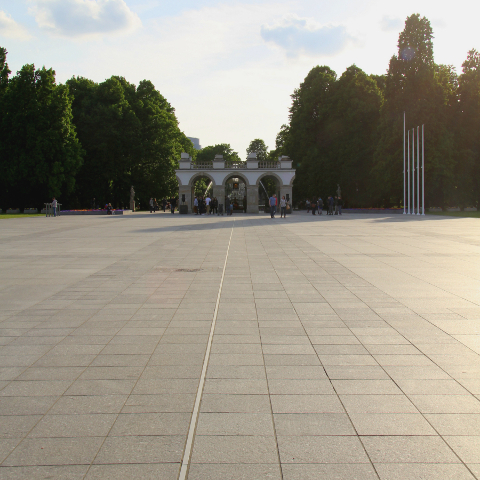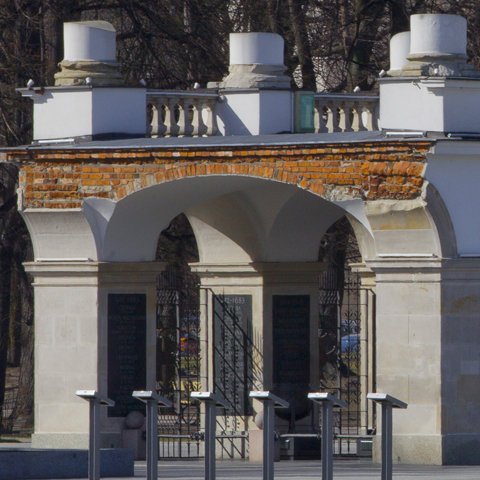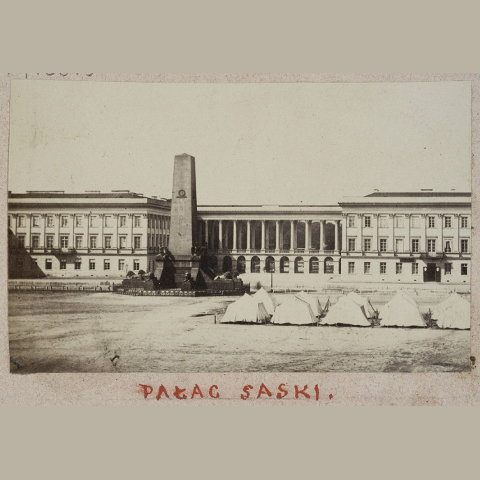Composers / Fryderyk Chopin / Places catalog
Saxon Palace
The Chopins’ fourth and last child, Emilia, was born in 1812, not long after Justyna, Mikołaj and the three older children had moved into an apartment in the Saxon Palace, where the Warsaw Lyceum was located.
The palace had once belonged to Andrzej Morsztyn, but was purchased in the early eighteenth century by King Augustus II the Strong. Augustus had the many other palaces he had purchased in the area demolished. Only the former seat of the Morsztyns, which he had selected for his residence, was spared. The king had a garden of almost 17 ha established in place of the palaces he had demolished. The beautiful Saxon Gardens were carefully protected by surrounding walls for 10–20 years before being opened to the public for the first time on 27 May 1727. During the reign of Stanislaus Augustus, the gardens were known as ‘Warsaw’s summer salon’, and only high society, the affluent, and those born into the nobility were entitled to enter. The shouting and rough-and-tumble of the pupils must have penetrated the silence and the rather stiff elegance of the place when the Warsaw Lyceum moved into the Saxon Palace in the early nineteenth century.
Count Fryderyk Skarbek, the son of a former employer of Mr and Mrs Chopin, as well as Fryderyk’s godfather, deliberately presents a rather distorted view of the palace and the gardens in his Pamiętniki Seglasa [Seglas’s memoirs]. Skarbek was versatile and perceptive, and by no means lacking in literary talent. His novel describes Warsaw as seen through the eyes of a foreigner, specifically a French governor modelled on Mikołaj Chopin. ‘It’s hard to admit’, notes the hero, ‘that these Saxon kings, of whom only the palace and gardens remain as a memento, established their residence in a better place than did the Polish kings. At least that the space is open and that the palace is situated between a large square and a garden. Everything is so desolate now. From Krakowskie Przedmieście, the high gate and the remains of the royal stables stand on two sides of the square. Only the palace was erected in the style of our buildings in the days of Louis XIV and Louis XV. It is only single-storey, but distinguished and extensive, and it traverses the entire width of the square. It has been set up as a college under the name Lyceum. The Prussians are running it, in order to ensure that the Polish youth are accustomed to the German language and qualified to take up studies in German academies. A spacious and once beautiful garden stretches out behind the palace. The Prussians have put up a tasteless arbour in the middle of it by remodelling the collapsing walls of a larger building that used to look like a triumphal gate. The public here deplores the ruins to which Lesla came for ice cream and call the new arbour the “henhouse”, on account of the wooden bars with which it is decorated on top, although they go there as they did before for their cold borsch and sweets, which I found delicious as well’.
We are not sure which part of the non-extant palace the Chopins occupied. One of the first major biographers of Chopin wrote that up to 1817 the composer’s family lived ‘in one of the buildings belonging to the Saxon Palace’. Other memoirs mention the right wing of the building and an apartment on the second floor, which would confirm that it was not in the main palace building.
Mikołaj Chopin and his wife ran a boarding house for pupils, as they did in their first apartment on Krakowskie Przedmieście, and as did other Lyceum teachers. ‘In the education system of those times, such a boarding school fulfilled a dual role’, explains Piotr Mysłakowski in The Chopins’ Warsaw, ‘it provided food, board and care for young people usually from outside Warsaw, and at the same time it offered a suitable programme of home tutoring. After a couple of years of such tutoring, a young boarder would sit the entrance exam and be accepted onto the third or fourth year of the Lyceum. And such was the case with Fryderyk Chopin. […] Such a system was founded first and foremost on the observance of quite strict regulations set out by the educational authorities relating to the running of such boarding schools, the qualifications of its staff and the level of educational supervision’.
Fryderyk spent his earliest childhood years in this apartment, only moving out with his family when he was seven or eight. It was here that he first learned to play the piano, when Wojciech Żywny came to give lessons to him and his sister. And it was here that his musical talent first became apparent.
-

Piłsudski Square. Place where was situated Saxon Palace. Phot. Łukasz Oracz.
-

Saved fragment of Saxon Palace. Today Tomb of the Unknown Soldier. Phot. Waldemar Kielichowski.
-

Saxon Palace, Karol Beyer. POLONA.